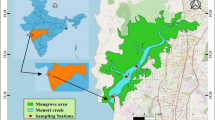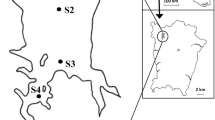Abstract
A novel strategy that allows to predict the responses of zooplanktonic species to environmental conditions in an estuarine temperate ecosystem (Mondego estuary) is presented. It uses 12 indicator species from the zooplanktonic Mondego database (102 species) that are common members of the different habitats, characterized by their specific hydrological conditions. Indicator-species analysis (ISA) was used to define and describe which species were typical of each of the five sampling stations in a 4-year study (2003–2006). First, a canonical correspondence analysis (CCA) was carried out to objectively identify the species-habitat affinity based on the relationship between species, stations and environmental data. Response curves for each of the zooplanktonic species, generated by univariate logistic regression on each of the independent variables temperature and salinity, were generally in agreement with the descriptive statistics concerning the occurrence of those species in this particular estuarine ecosystem. Species-specific models that predict probability of occurrence relative to environmental parameters like salinity, water temperature, turbidity, chlorophyll a, total suspended solids and dissolved oxygen were then developed for the zooplanktonic species. The multiple logistic models used contained between 1 and 3 significant parameters and the percentage correctly predicted was moderate to high, ranging from 62 to 95%. The predictive accuracy of the model was assured by direct comparison of model predictions with the observed occurrence of species obtained in 2006 (validation) and from data collected in the early 2000s in another Portuguese estuary—Ria de Aveiro (Canal de Mira), a complex mesotidal shallow coastal lagoon. The regression logistic model here defined, correctly suggested that the distribution of zooplankton species was mainly dependent on salinity and water temperature. The logistic regression proved to be a useful approach for predicting the occurrence of species under varying environmental conditions at a local scale. Therefore, this model can be considered of reasonable application (and should be tested in other estuarine systems) due to its ability to predict the occurrence of individual zooplanktonic species associated with habitat changes.





Similar content being viewed by others
References
Anger K (2003) Salinity as a key parameter in the larval biology of decapod crustaceans. Invertebr Reprod Dev 43:29–45
Azeiteiro UMM, Marques JC, Ré P (1999) Zooplankton annual cycle in the Mondego river estuary (Portugal). Arq Mus Bocage 3:239–263
Badosa A, Boix D, Brucet S, López-Flores R, Gascón S, Quintana XD (2007) Zooplankton taxonomic and size diversity in Mediterranean coastal lagoons (NE Iberian Peninsula): influence of hydrology, nutrient composition, food resource availability and predation. Estuar Coast Shelf Sci 71:335–346. doi:10.1016/j.ecss.2006.08.005
Beaugrand G (2004) The North Sea regime shift: evidence, causes, mechanisms and consequences. Prog Oceanogr 60:245–262. doi:10.1016/j.pocean.2004.02.018
Beaugrand G, Reid PC, Ibanez F, Lindley JA, Edwards M (2002) Reorganization of North Atlantic marine copepod biodiversity and climate. Science 296:1692–1694. doi:10.1126/science.1071329
Berasategui AD, Menu-Marque S, Gómez-Erache M, Ramírez FC, Mianzan HW, Acha EM (2006) Copepod assemblages in a highly complex hydrographic region. Estuar Coast Shelf Sci 66:483–492. doi:10.1016/j.ecss.2005.09.014
Blanco-Bercial L, Alvarez-Marques F, Cabal JA (2006) Changes in the mesozooplankton community associated with the hydrography off the northwestern Iberian Peninsula. ICES J Mar Sci 63:799–810. doi:10.1016/j.icesjms.2006.03.007
Bonnet D, Frid CLJ (2004) Seven copepod species considered as indicators of water-mass influence and changes: results from a Northumberland coastal station. ICES J Mar Sci 61:485–491. doi:10.1016/j.icesjms.2004.03.005
Cardoso PGM, Pardal MA, Lillebø AI, Ferreira SM, Raffaelli D, Marques JC (2004) Dynamics change in seagrass assemblages under eutrophication and implication for recovery. J Exp Mar Biol Ecol 302:233–248. doi:10.1016/j.jembe.2003.10.014
Cardoso PG, Raffaelli D, Lillebø AI, Verdelhos T, Pardal MA (2008) The impact of extreme flooding events and anthropogenic stressors on the macrobenthic communities’ dynamics. Estuar Coast Shelf Sci 76:553–565. doi:10.1016/j.ecss.2007.07.026
Cushing DH (1990) Plankton production and year-class strength in fish populations: an update of the match-mismatch hypothesis. Adv Mar Biol 26:249–293. doi:10.1016/S0065-2881(08)60202-3
Day J, Hall CAS, Kemp WM, Yanez-Arancibia A (1989) Estuarine ecology. Wiley, New York
Dolbeth M, Cardoso PG, Ferreira SM, Verdelhos T, Raffaelli D, Pardal MA (2007) Anthropogenic and natural disturbance effects on a macrobenthic estuarine community over a 10-year period. Mar Pollut Bull 54:576–585. doi:10.1016/j.marpolbul.2006.12.005
Dufrene M, Legendre P (1997) Species assemblages and indicator species: the need for a flexible asymmetrical approach. Ecol Monogr 67(3):345–366
Durbin AG, Durbin EG (1981) Standing stock and estimated production rates of phytoplankton and zooplankton in Narragansett Bay. R I Estuaries 4:24–41. doi:10.2307/1351540
Escaravage V, Soetaert K (1995) Secondary production of the brackish copepod communities and their contribution to the carbon fluxes in the Westerschelde estuary (The Netherlands). Hydrobiologia 311:103–114. doi:10.1007/BF00008574
Fernandez de Puelles ML, Valencia J, Jansa J, Morillas A (2004) Hydrographical characteristics and zooplankton distribution in the Mallorca channel (Western Mediterranean): spring 2001. ICES J Mar Sci 61:654–666. doi:10.1016/j.icesjms.2004.03.031
Fulton RS (1984) Distribution and community structure of estuarine copepods. Estuaries 7:38–50. doi:10.2307/1351955
Gaudy R, Cervetto G, Pagano M (2000) Comparison of the metabolism of Acartia clausi and A. tonsa: influence of temperature and salinity. J Exp Mar Biol Ecol 247:51–65. doi:10.1016/S0022-0981(00)00139-8
Halsband-Lenk C, Hirche HJ, Carlotti F (2002) Temperature impact on reproduction and development of congener copepod populations. J Exp Mar Biol Ecol 271:121–153. doi:10.1016/S0022-0981(02)00025-4
Hansson LJ, Moeslund O, Kiørboe T, Riisgård HU (2005) Clearance rates of jellyfish and their potential predation impact on zooplankton and fish larvae in a neritic ecosystem (Limfjorden, Denmark). Mar Ecol Prog Ser 304:117–131. doi:10.3354/meps304117
Hays GC (1996) Large scale patterns of diel vertical migration in the North Atlantic region. Deep Sea Res Part I Oceanogr Res Pap 43:1601–1615. doi:10.1016/S0967-0637(96)00078-7
Hays GC, Richardson AJ, Robinson C (2005) Climate change and marine plankton. Trends Ecol Evol 20:337–344. doi:10.1016/j.tree.2005.03.004
Hirst AG, Kiørboe T (2002) Mortality of marine planktonic copepods: global rates and patterns. Mar Ecol Prog Ser 230:195–209. doi:10.3354/meps230195
Hosmer D, Lemeshow S (2000) Applied logistic regression. Wiley, New York
Houghton JD, Doyle TK, Wilson MW, Davenport J, Hays GC (2006) Jellyfish aggregations and leatherback turtle foraging patterns in a temperate coastal environment. Ecology 87:1967–1972. doi:10.1890/0012-9658(2006)87[1967:JAALTF]2.0.CO;2
Hughes L (2000) Biological consequences of global warming: is the signal already apparent? Trends Ecol Evol 15:56–61. doi:10.1016/S0169-5347(99)01764-4
IPCC (2007) Climate change 2007: the Physical Science Basis. Summary for Policymakers, Paris, February 2007
Kiorboe T, Nielsen TG (1994) Regulation of zooplankton biomass and production in a temperate, coastal ecosystem. 1. Copepods. Limnol Oceanogr 39:493–507
Lance J (1963) The salinity tolerance of some estuarine plankton copepods. Limnol Oceanogr 8:440–449
Leandro SM, Queiroga H, Rodriguez L, Tiselius P (2006) Temperature dependent development and somatic growth in two allopatric populations of Acartia clausi (copepoda: calanoida). Mar Ecol Prog Ser 322:189–197. doi:10.3354/meps322189
Marques SC, Azeiteiro UM, Marques JC, Neto JM, Pardal MA (2006) Zooplankton and ichthyoplankton communities in a temperate estuary: spatial and temporal patterns. J Plankton Res 28:297–312. doi:10.1093/plankt/fbi126
Marques SC, Azeiteiro UM, Martinho F, Pardal MA (2007) Climate variability and planktonic communities: the effect of an extreme event (severe drought) in a southern European estuary. Estuar Coast Shelf Sci 73:725–734. doi:10.1016/j.ecss.2007.03.010
Martinho F, Leitão R, Viegas I, Dolbeth M, Neto JM, Cabral HN et al (2007) The influence of an extreme drought event in the fish community of a southern Europe temperate estuary. Estuar Coast Shelf Sci 75:537–546. doi:10.1016/j.ecss.2007.05.040
McLusky DS, Elliott M (2004) The estuarine ecosystem. Oxford University Press, Oxford
Moreira MH, Queiroga H, Machado MM, Cunha MR (1993) Environmental gradients in a southern estuarine ecosystem: Ria de Aveiro, Portugal. Implication for soft bottom macrofauna colonization. Neth J Aquat Ecol 27:465–482. doi:10.1007/BF02334807
Mouny P, Dauvin J-C (2002) Environmental control of mesozooplankton community structure in Seine estuary (English Channel). Oceanol Acta 25:13–22. doi:10.1016/S0399-1784(01)01177-X
Paiva V, Ramos JA, Martins J, Almeida A, Carvalho A (2008) Foraging habitat selection by Little Terns Sternula albifrons in an estuarine lagoon system of southern Portugal. Ibis 150:18–35
Pardal MA, Marques JC, Metelo I, Lillebø AI, Flindt MR (2000) Impact of eutrophication on the life cycle, population dynamics and production of Ampithoe valida (Amphipoda) along an estuarine spatial gradient (Mondego estuary, Portugal). Mar Ecol Prog Ser 196:207–219. doi:10.3354/meps196207
Pearson DL (1994) Selecting indicator taxa for the quantitative assessment of biodiversity. Philos Trans Roy Soc Lond B 345:75–79
Perez-Ruzafa A, Gilabert J, Gutierrez JM, Fernandez AI, Marcos C, Sabah S (2002) Evidence of a planktonic food web response to changes in nutrient input dynamics in the Mar Menor coastal lagoon, Spain. Hydrobiologia 475/476:359–369. doi:10.1023/A:1020343510060
Queiroga H, Blanton J (2004) Interactions between behaviour and physical forcing in the control of horizontal transport of decapod crustaceans larvae. Adv Mar Biol 47:107–204. doi:10.1016/S0065-2881(04)47002-3
Roddie BD, Leakey RJG, Berry AJ (1984) Salinity-temperature tolerance and osmoregulation in Eurytemora affinis (Poppe) (Copepoda: Calanoida) in relation to its distribution in the zooplankton of the upper reaches of the Forth estuary. J Exp Mar Biol Ecol 79:191–211. doi:10.1016/0022-0981(84)90219-3
Russell FS (1973) Hydrographical and biological conditions in the North Sea as indicated by plankton organisms. J Cons Int Explor Mer 14:171–192
Tackx MLM, Nathalie DP, Riet VM, Azemar F, Abdelhacq H, Stefan VD et al (2004) Zooplankton in the Schelde estuary, Belgium and The Netherlands. Spatial and temporal pattern. J Plankton Res 26:133–141. doi:10.1093/plankt/fbh016
Ter Braak CJF, Smilauer P (1998) CANOCO Reference Manual and User’s Guide to Canoco for Windows: Software for Canonical Community Ordination (version 4). Microcomputer Power, Ithaca, New York
Thrush SF, Hewitt JE, Herman PMJ, Ysebaert T (2005) Multi-scale analysis of species–environment Relationships. Mar Ecol Prog Ser 302:13–26. doi:10.3354/meps302013
Warner AJ, Hays GC (1994) Sampling by the continuous plankton recorder survey. Prog Oceanogr 34:237–256. doi:10.1016/0079-6611(94)90011-6
Whitman RL, Meredith BN, Goodrich ML, Murphy PC, Bruce MD (2004) Characterization of Lake Michigan coastal lakes using zooplankton assemblages. Ecol Indic 4:277–286. doi:10.1016/j.ecolind.2004.08.001
Ysebaert T, Meire P, Herman P, Verbeek H (2002) Macrobenthic species response surfaces along estuarine gradients: prediction by logistic regression. Mar Ecol Prog Ser 225:79–95. doi:10.3354/meps225079
Acknowledgments
The present work was supported by I.·I. I. (Instituto de Investigação Interdisciplinar of the University of Coimbra) through a Ph.D grant awarded to S. C. Marques (III/AMB/28/2005). A special thanks to all colleagues who helped during field work.
Author information
Authors and Affiliations
Corresponding author
Additional information
Communicated by S.A. Poulet.
Rights and permissions
About this article
Cite this article
Marques, S.C., Azeiteiro, U.M., Leandro, S.M. et al. Predicting zooplankton response to environmental changes in a temperate estuarine ecosystem. Mar Biol 155, 531–541 (2008). https://doi.org/10.1007/s00227-008-1052-6
Received:
Accepted:
Published:
Issue Date:
DOI: https://doi.org/10.1007/s00227-008-1052-6




